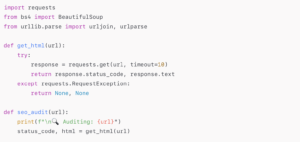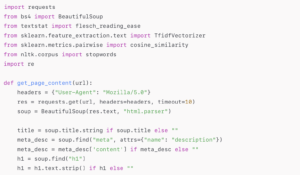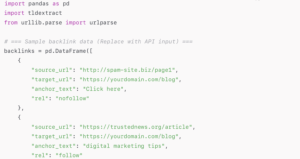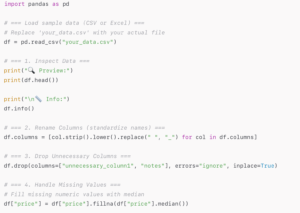Source: Freepik
Search engine optimization is a complex process that involves lots of repetitive tasks. Although they all are important, handling them manually takes too much time and distracts you from the most crucial tasks such as refining your strategy and improving performance in search engines.
Luckily, these days, SEO can be automated in a number of ways, and using Python is one of the most effective ones that can save you many hours on routine tasks.
Why Use Python for SEO?
Although it may seem unrelated at first, Python and SEO have been going well together for a fairly long time. With the help of this language, SEO professionals can scrape web data and automate a variety of daily tasks to make the most out of their efforts. Besides, this programming language is widely used to develop SEO-focused tools that help with day-to-day tasks.
Okay, but isn’t it too complicated? Apart from being one of the most common programming languages out there, it is also known for being relatively simple. Its syntax resembles natural language, which makes it quite intuitive for beginners. To get started, all you need is to know the primary libraries and tools that can aid with daily SEO tasks.
Python SEO: 6 Essential Libraries to Use
In a nutshell, Python libraries are collections of reusable, pre-written code that you can use for various purposes. Here is an overlook of the main libraries that can be deployed to solve search engine optimization challenges:
- BeautifulSoup—This is the ultimate Python web scraping library. With its help, you can scrape metadata, page content, and headings for one particular URL or even a list of URLs.
- Requests—This library enables you to create HTTP requests to fetch data from websites and APIs, including yours and your competitors’ sites.
- Selenium—This library has a number of uses in SEO. It lets you build scripts that trigger an automatic sequence of actions. For example, it can be used for streamlining link-building outreach, social media engagement, and even on-page optimization.
- Pandas—This library is a real powerhouse for data manipulation. With its help, you can clean, organize, and summarize large datasets, such as important SEO metrics like traffic, keyword performance, and others, for further analysis
- NumPy—This library can also support data manipulations. It lets you process and analyze performance metrics and competitor data, while also handling calculations.
- Matplotlib / Seaborn— These libraries are there for data visualization. You can use it to create clear graphs and charts that visualize important data, such as keyword trends, impressions, CTR, etc.
- re (Regular Expressions)—This library is a powerful tool for extracting specific SEO data from code or content. It lets you refine keyword research, filter search queries, and add precision to your content optimization.
Key Use Cases of Python Tools for SEO Automation
As you already know, different libraries can make a solution to a range of optimization tasks. Yet, automating repetitive tasks is one of the primary purposes of leveraging this programming language in search engine optimization.
To help you grasp the concept better, let’s look at the main use cases of Python for SEO automation:
- Keyword research—Data scraping libraries, such as BeautifulSoup, can let you fetch keyword data, such as search volume, competition, and others, with no manual effort.
- SEO auditing—With the help of the right Python script for SEO, you can run automated site crawls and detect various errors, such as slow page speed, broken links, duplicate content, and others, in almost no time.
- Content optimization—Using this programming language, you can streamline the process of content optimization by automating content analysis. For example, you can audit your pages for readability, semantic relevance, and keyword placement to detect actionable insights for improving your copy.
- SERP analysis—This programming language enables you to set up automatic SERP tracking at scheduled intervals. This will let you gain real-time insights into your site’s performance in search engines without having to check it manually.
- Backlink analysis—Lastly, using this language enables you to put link analysis on autopilot and thus, detect lost or toxic links more easily and improve your backlink profile.
Combining Python and API Integration for Deeper Insights
As you already know, you can scrap a variety of data types from your site, competitors’ websites, and the web using Python tools. One way to deepen your insights is to leverage the Application Programming Interface (API) to streamline communication between your scripts and various SEO software.
The opportunities for bringing together Python and APIs are endless. For example, to gain more accurate keyword research insights, you can use APIs like Google Ads, which can let you explore promising keyword opportunities without a hassle. To improve backlink analysis, you need to leverage APIs like SE Ranking or Majestic—just pick the best tool for backlink analysis and let your scripts gather link data from it.
Python Script for SEO: 5 Scripts That Can Save Your Time
Now that you know about the main libraries, use cases, and API integrations that can help you make the most out of your Python SEO, let’s look at specific script examples that can streamline your workflow and save lots of time on tedious manual tasks:
1. Keyword Research
Try this script to receive practical keyword suggestions using Google Ads API:
Source: Screenshot
2. SEO Auditing
Streamline the process of auditing your (or your competitor’s) website using this SEO analyzer script:
Source: Screenshot
3. Content Optimization
If you want to analyze page content, try using this script:
Source: Screenshot
4. SERP Analysis
If you want to pull real-time insights from SERPs, you can do this using the following example:
Source: Screenshot
5. Backlink Analysis
To assess the quality of your backlink profile, you can try this example:
Source: Screenshot
Streamlining Reporting and Data Visualization
Using libraries like Requests and BeautifulSoup and supporting APIs like Google Analytics and Search Console, you can quickly and easily extract important data from the web. However, the data you will scrape will be presented in the form of a large dataset that is quite hard to handle.
Luckily, you can take a few additional steps to manipulate and visualize it for reporting purposes.
First, leverage Panda to clean and transform raw data. Here is an example of code that can be used for detecting missing data and cleaning your dataset:
Source: Screenshot
After you clean your raw data, group it by specific dimensions for simpler reporting and interpretation.
Source: Screenshot
After you clean and organize the information you obtained from web scraping, here’s an example of code that can be used for this purpose:
Source: Screenshot
Similarly, you can find other reusable code pieces in the chosen library to visualize your data in other ways, for example, in line graphs, bar charts, etc.
How to Use Python for SEO: Simple Tips for Getting Started
Although it can seem quite overwhelming at first, getting started with Python for SEO really isn’t that complicated. Here is a set of simple tips for getting you on the right track:
- Go to Python.org and download the latest version of the language available for your operating system.
- Install the key libraries outlined above.
- Pick APIs that go well with Python.
- Start with simple scripts to audit your site, check content quality, etc.
- Experiment and delve deeper into the possibilities offered by this programming language to boost your optimization results.
Conclusion
Python is a versatile programming language that has multiple applications beyond web development. As you now know, it can become a powerful addition to your SEO toolkit. With its help, you can automate a wealth of repetitive tasks that take lots of your time and focus on important tasks instead.
With this guide, getting started with this programming language should become simple. So don’t wait and start using the possibilities offered by this language to streamline your workflow and achieve greater results.









